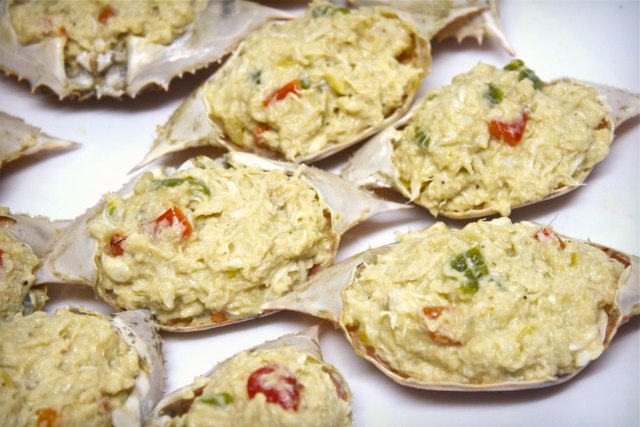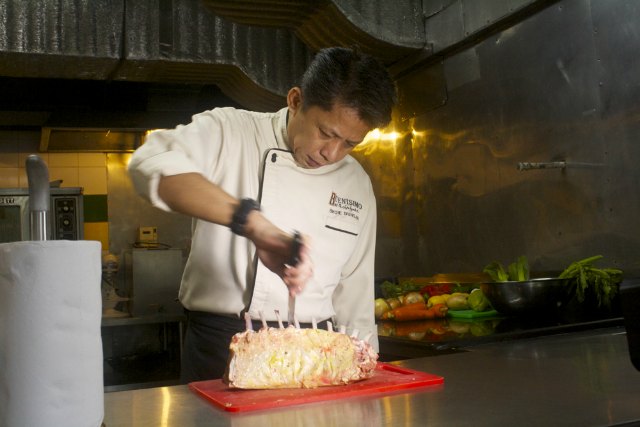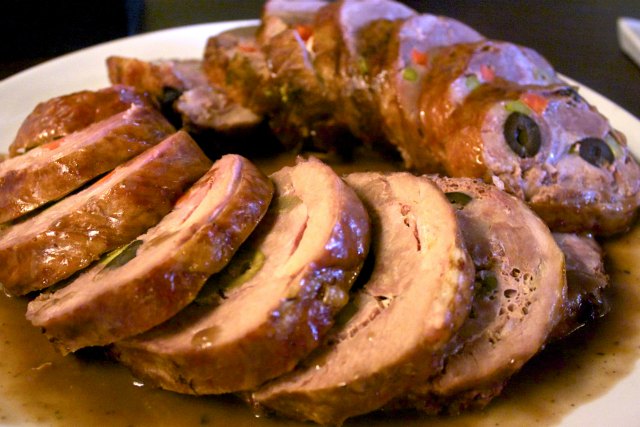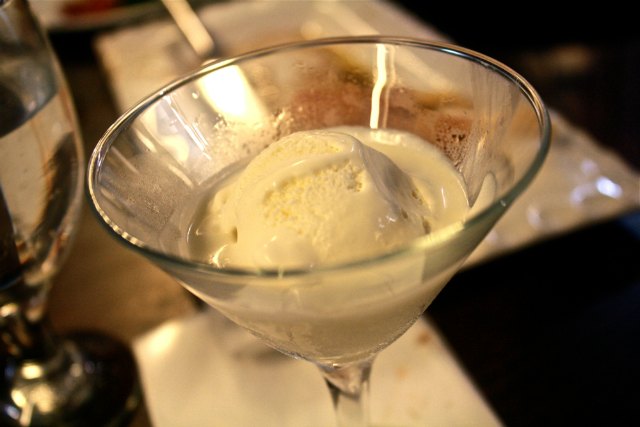Filtered by: Newstv
NewsTV
Food as Resurrection: The Malolos Banquet at Café Ysabel
By LAUREL FANTAUZZO
Red radishes cut in the careful shape of a fan, topped with an articulate swirl of butter. Perfect red discs of sliced, glistening tomatoes, topped by small, salty strips of canned sardines. Pale yellow asparagus spears, sheathed with red prosciutto. Stuffed crabs filled with bell peppers, topped with crisped slivers of cheese. Chunks of lamb balanced delicately on their pencil-sized bones, wrapped in paper.
The food of the Malolos Banquet composed an elegant feast. It also composed a slightly surprising feast, sourced as it was from the cans, methods, and larders of other Western nations.  “Not Filipino?” said Congresswoman Sandy Ocampo, as she sat at the recreated table in Café Ysabel. She had expected, perhaps, a banquet emphasizing the cuisine Bulacan. She ordered a shake right away; dalandan, the native citrus fruit. Chikee Ocampo took his seat at the table near her. So did Benito Legarda VI. (Click here to watch an excerpt from Part 1 of "Sa Hapag ng mga Bayani.")
“Not Filipino?” said Congresswoman Sandy Ocampo, as she sat at the recreated table in Café Ysabel. She had expected, perhaps, a banquet emphasizing the cuisine Bulacan. She ordered a shake right away; dalandan, the native citrus fruit. Chikee Ocampo took his seat at the table near her. So did Benito Legarda VI. (Click here to watch an excerpt from Part 1 of "Sa Hapag ng mga Bayani.")
 “Not Filipino?” said Congresswoman Sandy Ocampo, as she sat at the recreated table in Café Ysabel. She had expected, perhaps, a banquet emphasizing the cuisine Bulacan. She ordered a shake right away; dalandan, the native citrus fruit. Chikee Ocampo took his seat at the table near her. So did Benito Legarda VI. (Click here to watch an excerpt from Part 1 of "Sa Hapag ng mga Bayani.")
“Not Filipino?” said Congresswoman Sandy Ocampo, as she sat at the recreated table in Café Ysabel. She had expected, perhaps, a banquet emphasizing the cuisine Bulacan. She ordered a shake right away; dalandan, the native citrus fruit. Chikee Ocampo took his seat at the table near her. So did Benito Legarda VI. (Click here to watch an excerpt from Part 1 of "Sa Hapag ng mga Bayani.") Emilio Aguinaldo IV entered; his resemblance to the soldierly bearing of his ancestor is striking, down to his short-cropped, military haircut. He was surprised when he saw his eating agenda. “I was expecting Filipino food or Spanish food, because it was the victory of the Philippines,” he said.
The diners were here to enjoy one of the most pivotal Filipino meals in history, which their ancestors had enjoyed before them. But the contradiction was notable. The Malolos Congress’ banquet celebrated Philippine independence. Its recipes were dependent on outsider nations. Which was not to say that the food was not delicious. It was. This was food as resurrection, food as investigation, food as faithful, toothsome reproduction. Chef Gene Gonzalez had practice, having prepared this meal annually since the 1998 centennial of the Malolos Congress. His own ancestor, Captain Joaquin Arnedo Cruz, had prepared the original meal, journeying with his family’s most skilled cooks for the task. Cruz was used to serving the palates of famous outsiders; he and his staff prepared feasts for two MacArthurs, a Grand Duke, and sundry other aristocracy who traveled to the Philippines in the 19th century. Chef Gonzalez himself served Prince Andrew and Queen Sofia European-style feasts in recent years, though for Filipino presidents, he reverted to stylized Filipino.
For his first recreation of the Malolos banquet in 1998, Chef Gonzalez questioned elderly cooks and their descendants about mysteries he found on the menu. How was the turkey prepared, European-style roast turkey having been an impossibility then? How could the butter possibly survive?
He acquired canned sardines, canned asparagus, imported butter, imported vegetables. He understood why his ancestors had de-emphasized their relatively unknown local cuisine in the meal. 

“We were considered indios,” Chef Gonzalez said. “Where to show the world we weren't your ignorant natives? That there was a form of culture present in the country?”
The original meal, then, was food as performance. It was a menu that told powerful outsiders, in French, that the Filipinos could stand on equal footing with theirs, as an independent, cultivated nation. It was a show. The original Ocampo, Aguinaldo, and Legarda wore tails and top hats. Wool suits in Malolos, in the heat of September! “That’s a mean show!” Chef Gonzalez laughed.
Chef Gonzalez stood before the recreated banquet table, held the menu, and pointed out each of the courses to Sandy Ocampo, Chikee Ocampo, Benito Legarda VI, and Emilio Aguinaldo IV now. The descendants did not dress in the manner of their ancestors, though they were likely as busy as their ancestors. They wore barongs, cotton button-downs, and orange polo shirts, on their way to the other meetings and official obligations of their stations.
“I don’t know how Filipinos handle the butter,” Chef Gonzalez said thoughtfully, looking at the radishes he’d prepped in the French style of a quick snack. “You be the judge.”
The radishes went unfinished, though the diners gamely tried them. They murmured in appreciation at the perfect square of tender salmon dressed in béchamel sauce; fresh salmon, Chef’s slight deviation from the original canned fish. Then came the delicately constructed puff pastries with their rich, carnivorous filling. Then the beef tenderloin, and the turkey. 

It would be inexact to say that Filipino food was entirely absent from the menu. Filipino methods were there, subtly, quietly. The buttery puff pastries? Filled with lengua, among the sweetbreads, mushrooms. The turkey? It was ala Manilloise; prepared for hours as a spoon-tender embutido, studded with olives and carrots. The intriguingly titled Abati depaulet a la Tagale? It was an adobo. The dark, patriotic marinade of soy sauce, vinegar, bay leaves, and peppercorns dressed a rich assemblage of chicken livers. Chicken liver, Chef explained, was an offal acceptable to the romance-language-speaking nations, from a Tagalog-language-speaking nation. Using this ingredient in a traditional adobo intended to showcase a native, national Filipino dish of international quality.
The original Malolos meal ended with ice creams. Ice, in the 19th century, was imported in ships from Boston, packed in sawdust, then parceled out carefully to the iceboxes of wealthy Filipino families. What emerged from the electric freezer now was homemade ice cream fragrant with fresh lemongrass; lemongrass gatas na halabon. Whether or not the recipe was faithful to the original ice cream flavors of the Malolos Congress, it was creamy and sweet enough to inspire an appreciative hand over one’s sated heart. “Perfect,” the diners murmured. 

“While going here I don’t know how to feel,” said the fourth Emilio Aguinaldo, when he stood from the table. “Probably I have goosebumps.” It was strange and quietly momentous for him to eat what his revolutionary ancestor had eaten. Aguinaldo IV was a meat lover, and he liked the succession of lamb, beef tenderloin, lengua, and liver adobo. He understood, now, the impulse of the chefs serving his famous Lolo. Filipinos wanted to prove they could compare with the rest of the world. They deserved an equal seat at the world’s table. — Photos by Cristina Tantengco, GMA News Watch Part 2 of "Sa Hapag ng mga Bayani" on September 2, Sunday, 8:45 PM on GMA News TV Channel 11.
More Videos
Most Popular




